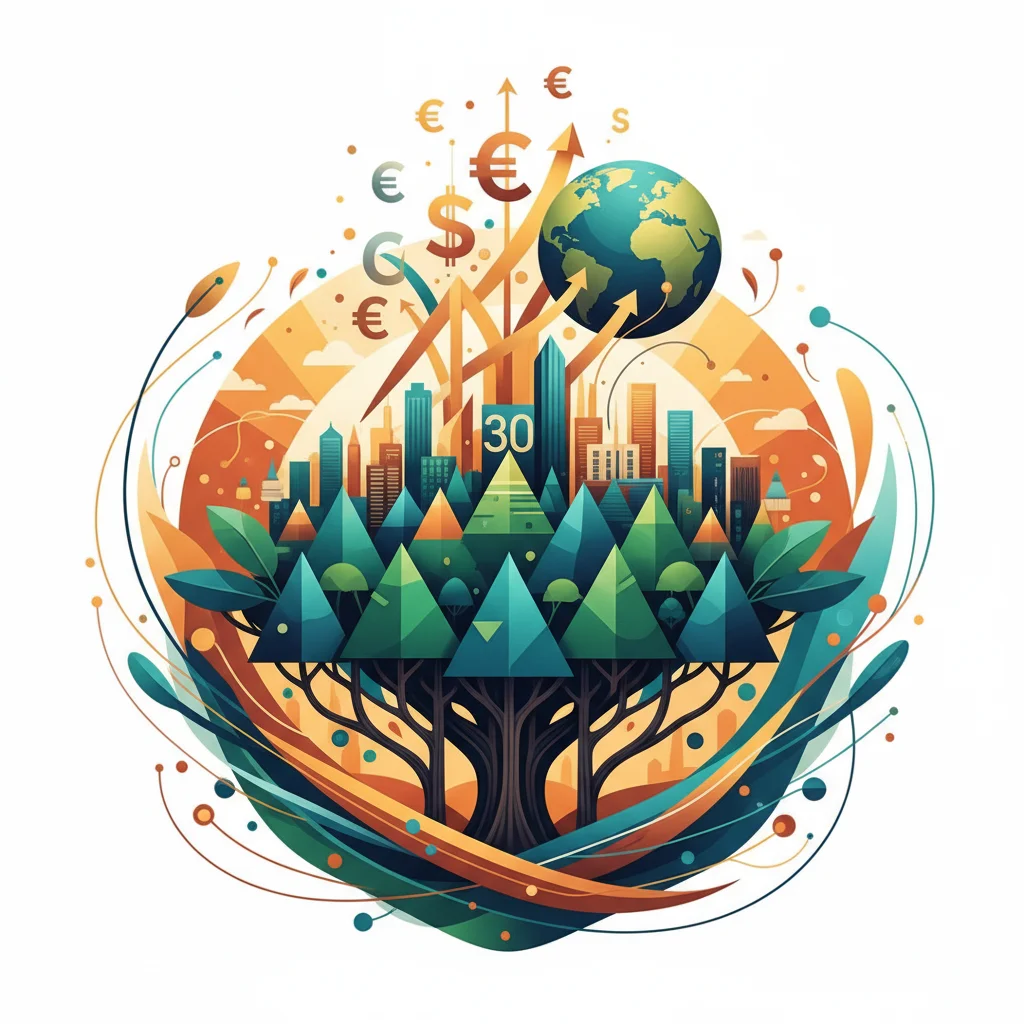
Beyond the Canopy: Why COP30’s Forest Finance Initiative is a Critical Test for the Global Economy
As the world gears up for the 30th Conference of the Parties (COP30) in Belém, Brazil, the financial and business communities are watching with unprecedented interest. Hosted in a city often called the gateway to the Amazon, this summit is poised to be more than just another climate negotiation. It will be a pivotal moment where environmental stewardship and global finance intersect, with the fate of the world’s tropical forests—and the stability of our economy—hanging in the balance. At the heart of this high-stakes event is a proposed international finance initiative for tropical forests, a plan that, as noted by the World Resources Institute, represents a “make-or-break test” for global climate goals.
For investors, banking leaders, and fintech innovators, this isn’t a distant environmental issue; it’s a direct signal of a seismic shift in the market. The conversation is no longer just about conservation; it’s about capitalization, risk mitigation, and identifying the next frontier of sustainable investing. The success or failure of this initiative will send shockwaves through the stock market, commodity trading, and the very architecture of our financial system. This article delves into why the financial world must pay close attention to COP30, exploring the immense economic risks of inaction and the multi-trillion-dollar opportunities that await those who can successfully finance the future of our planet’s green lungs.
The Economic Imperative: Why Forests are a Financial Asset
For too long, tropical forests have been viewed through a purely environmental lens. In modern economics, however, their value is increasingly being quantified in financial terms. These ecosystems are not just collections of trees; they are critical infrastructure for the global economy. They regulate weather patterns essential for agriculture, act as the world’s most effective carbon capture technology, and house a wealth of biodiversity that underpins industries from pharmaceuticals to tourism.
The financial risks associated with their destruction are staggering. Deforestation directly impacts supply chains for key commodities like soy, palm oil, coffee, and beef, leading to price volatility that affects trading desks and consumer prices alike. According to the World Economic Forum, more than half of the world’s total GDP, or $44 trillion of economic value generation, is moderately or highly dependent on nature and its services. The continued degradation of these natural assets represents a systemic risk to the global economy, comparable to the shocks of a banking crisis.
The global community has committed to “end and reverse deforestation by 2030,” a noble goal with a colossal price tag. The challenge, as highlighted by the original letter, is the monumental gap between ambition and capital. Current financial flows are a mere trickle when a flood is needed. The UN estimates that to meet our collective climate, biodiversity, and land degradation targets, annual investments in nature-based solutions must triple by 2030 to over $536 billion. This is where the proposed COP30 initiative becomes a critical catalyst, designed to orchestrate a “step change” in both public and private finance.
Beyond the 2008 Ghost: Why Europe's Securitisation Market Deserves a Second Look
A “Step Change” in Finance: Deconstructing the Investment Blueprint
Achieving this “step change” requires a sophisticated, multi-layered approach that moves beyond traditional philanthropy and government aid. It demands the full mobilization of the global financial system, from multilateral development banks to disruptive fintech startups. This new era of conservation finance will be built on innovative models that blend public de-risking with private sector efficiency and scale.
The Role of Public and Blended Finance
Public capital is the bedrock. Governments and institutions like the World Bank must provide the initial, risk-tolerant capital that makes large-scale forest projects viable for private investors. This can take several forms:
- Concessional Loans: Offering lower-interest, longer-term loans to projects that may not meet traditional risk-return profiles.
- Guarantees: Using public funds to underwrite a portion of private investment, protecting against political or project-specific risks.
- Carbon Pricing Mechanisms: Implementing national or regional carbon taxes and emissions trading schemes that create a tangible economic cost for pollution and a revenue stream for conservation.
The Private Sector’s Trillion-Dollar Opportunity
With public finance providing a safety net, the door opens for massive private investment. This is where the worlds of banking, trading, and financial technology will converge to create new markets and asset classes.
- Investing & The Stock Market: The rise of ESG (Environmental, Social, and Governance) criteria is already reshaping investment mandates. We will see an explosion in green bonds specifically earmarked for reforestation, impact funds targeting sustainable agriculture, and private equity ventures focused on “nature-tech.” Companies with transparent, deforestation-free supply chains will command a premium on the stock market, while those with exposure will face increasing investor scrutiny and divestment.
- Banking & Lending: The banking sector will play a crucial role in financing the transition. This means shifting lending portfolios away from activities linked to deforestation and towards providing green loans for sustainable land use, eco-tourism infrastructure, and the development of non-timber forest products.
- Fintech & Blockchain: The Game-Changers: This is arguably the most exciting frontier. Financial technology offers the tools to solve two of the biggest historical challenges in conservation: transparency and verification.
- Blockchain can create immutable records for carbon credits, ensuring they are not double-counted and providing a transparent chain of custody from the forest project to the corporate buyer. It can also be used to track commodities through the supply chain, certifying them as “deforestation-free” for consumers and regulators.
- Fintech platforms, powered by AI and satellite imagery, can monitor forest health in real-time, providing investors with verifiable data on the impact of their capital. This technology transforms a donation into a data-backed investment, revolutionizing Measurement, Reporting, and Verification (MRV).
Navigating the Obstacles: Challenges and Financial Solutions
The path to financing a green future is fraught with obstacles. However, each challenge presents a corresponding opportunity for financial innovation. For business leaders and investors, understanding this landscape is key to positioning for success.
The table below outlines the primary hurdles and the emerging financial market solutions designed to overcome them.
| Challenge | Financial Sector Opportunity / Solution |
|---|---|
| Lack of “Investable” Projects | Development of specialized project finance teams, private equity funds, and venture capital dedicated to incubating and scaling nature-based projects to a size attractive for institutional investors. |
| High Political & Regulatory Risk | Creation of sophisticated insurance products against political instability, blended finance structures with MDB guarantees, and long-term offtake agreements for carbon credits to secure revenue streams. |
| Complex MRV (Measurement, Reporting, Verification) | Investment in “nature-tech” companies using satellite, drone, and AI technology for verification. Development of standardized accounting principles for natural capital, driven by fintech and audit firms. |
| Ensuring Social Equity & Community Benefit | Growth of impact investing funds with specific mandates for community benefit sharing. Use of blockchain for transparent and direct payment systems to indigenous and local communities. |
The Trillion-Dollar Handshake: Unpacking the Global Economic Stakes of the Trump-Xi Summit
COP30: The Moment of Truth for the Global Economy
Holding COP30 in Belém is a powerful symbolic statement. It forces the global community to confront the reality of deforestation on its doorstep. The success of this summit will not be measured in vague promises, but in the concrete financial commitments and market mechanisms that emerge.
For the financial world, a successful outcome would mean clarity. It would provide the policy signals and standardized frameworks needed to unlock private capital at scale. It would legitimize natural capital as a formal asset class, creating new markets for trading carbon, biodiversity credits, and other ecosystem services. A failure, however, would perpetuate uncertainty, increase systemic risk in the global economy, and represent a colossal missed opportunity for innovation and growth.
President Lula’s leadership, and Brazil’s position as custodian of the world’s largest rainforest, places the nation at the epicenter of this economic transformation. The tropical forest finance initiative is not just a test of his climate credentials; it’s a test of our collective ability to reform our economic system to value nature properly.
The £150 Billion Problem: How Britain's Health Crisis is Quietly Crippling its Economy
The message for every investor, banker, and business leader is clear: the economics of conservation are no longer a niche topic for ESG reports. They are becoming central to mainstream finance. The discussions at COP30 will define the rules of the game for decades to come. The question is no longer *if* we should invest in our planet’s natural infrastructure, but *how* we can do so profitably, sustainably, and at the immense scale required. The answer will determine the health of both our forests and our portfolios.


